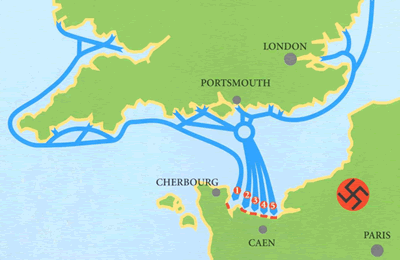 In the history of ground warfare, there may be no more historic battle than the one that occurred on the coast of France in June of 1944, which came to be known as D-Day. Not only was the Allied invasion the largest ever attempted during World War II, it became the single more ambitious ground warfare effort ever carried out.
In the history of ground warfare, there may be no more historic battle than the one that occurred on the coast of France in June of 1944, which came to be known as D-Day. Not only was the Allied invasion the largest ever attempted during World War II, it became the single more ambitious ground warfare effort ever carried out.
In the history of ground warfare, there may be no more historic battle than the one that occurred on the coast of France in June of 1944, which came to be known as D-Day. Not only was the Allied invasion the largest ever attempted during World War II, it became the single more ambitious ground warfare effort ever carried out. The 150,000 men, 5,000 ships, 50,000 vehicles, and 11,000 planes that took part in this massive military maneuver would successfully carry out an invasion so massive that it is almost incomprehensible even today.
But it was an invasion that turned the tide of the war against the Axis powers which eventually brought victory to the Allies against Hitler and his allies.The force to be landed to invade France and begin the surge that would turn Hitler’s advance around was so massive that it took some time to just select beaches that could handle such an invading army.
Finally, the beaches that came to be known as Juno, Utah, Sword, and Omaha became the location of the largest World War 2 ground battle of all time. D-Day was meticulously planned to coordinate a huge army of thousands of military units to bring a coordinated invasion by land, sea and air and utilizing the militaries of dozens of nations all in one strategic effort to break the back of Hitler’s hold on Europe.
Entire volumes have been written about the phenomenal effort that took place to not only keep secret this huge undertaking from the Germans but to distract them to other locations so that when the Allied forces stormed the beaches of Normandy, the German’s would be poorly prepared to respond. But even before the hour came for those tens of thousands of ships and soldiers to come ashore to storm those beaches, thousands of paratroopers had landed behind the lines and secured the roads and bridges to box the enemy in when the Allies began to prevail.
This is not to say that by any measure, the invasion was not a costly one. The landing on those five beaches was coordinated to drive inland and reach specific strategic locations by the end of the first day. But the fighting was fierce and difficult. Omaha beach of the five was by far the bloodiest conflict of the encounter. Thousands of allied soldiers died coming off their landing craft or in the waters of Omaha beach as others pushed forward to battle for every yard of land they took over the next two days.
Omaha beach was surrounded by steep cliffs and the German army had set up nearly impervious defenses there that they used to pound the allied landing force. Of the 9000 men who died in the attacks on D-Day, a third of them died on Omaha beach. It took the combined efforts of air strikes and commandos who struck those German defenses from the rear before our men were able to finally secure the beach and connect with the rest of the D-Day force to press on to achieve the goals of the invasion.



But their heroism was not in vain because it was D-Day that gave the Allies the victory they needed to attack Hitler and eventually defeat him in Europe. The final victory over Hitler and his Axis forces was in no small amount due to the heroism of those thousands of men who invaded the beaches of Normandy on D-Day.
